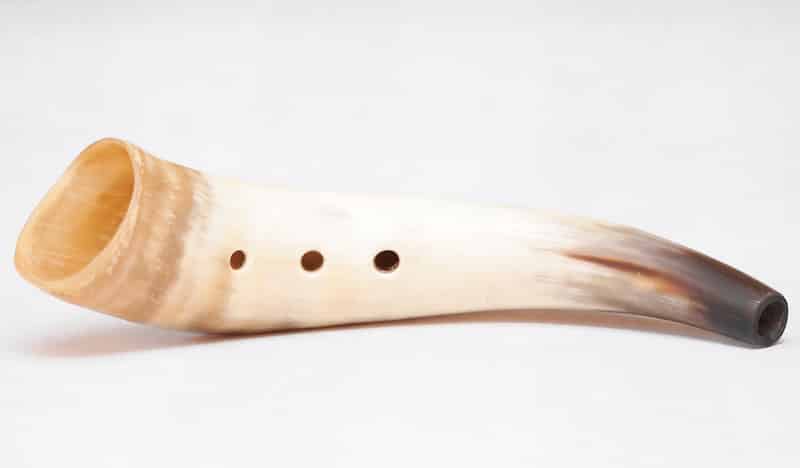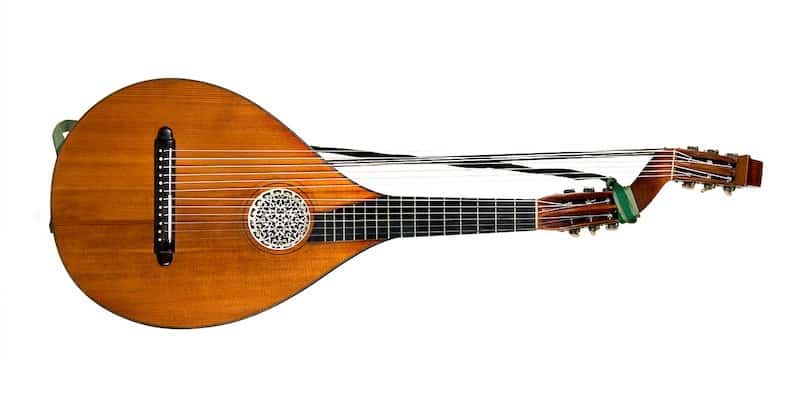Sweden, the country that gave us great meatballs, IKEA, and some great pop music, also has a lot to offer in terms of its folk instruments. Swedish music has evolved over time, starting from a deep history of folk music that was based on instruments built from utterly simple objects, like whistles made from birch trees, to intricate stringed instruments like theNyckelharpa.
So, in this post, we’re going to explore 13 Swedish musical instruments that not only reflect Sweden’s Scandinavian heritage but also how the country’s music came to evolve with the ages. Let’s get started.
1. Nyckelharpa
It’s only appropriate to start our list with Sweden’s national instrument, the Nyckelharpa.
The Nyckelharpa – which in Swedish translates to ‘Key Fiddle’ – is the quintessential Swedish instrument and arguably one of the most iconic, owing to its unique and intricate shape.
Dating back all the way to 1350, the earliest example of the instrument is a small carving on one of the gates of the Källunge church on the Island of Gotland. The carving on the gates depicts two players of Nyckelharpa.
When it comes to the functionality of the Nyckelharpa, at its core, it’s sort of a cross between a violin and hurdy-gurdy using a bow to play strings but using keys to change the pitch of the notes.
Its defining feature that makes it so iconic is definitely 37 keys attached along the neck that the player presses down with their left hand.
2. Psalmodikon
The Psalmodikon or Salmodikon is another type of string instrument that’s made up of a long box with a string attached at each end.
The musician then plucks the string or uses a bow like a violin to cause it to vibrate and create the sound.
To change the pitch of the instrument, the player can then press down on one of 25 steps along the length of the box, each of which is a half-step difference in pitch.
Its invention is thought to have been for the church as most congregations couldn’t afford an expensive organ.
They also didn’t think that violins – which were used for dancing – were inappropriate to be used in a religious setting.
So, they created a simple, affordable, and appropriatePsalmodikon to use in accompanying the singing congregation.
3. Moraharpa
Next, we have the Moraharpa, which looks and sounds very similar to the Nyckelharpa. In fact, you could think of it as the Nyckelharpa’s grandfather as it was one of the earliest predecessors.
Constructed with much of the same features, aMoraharpa looks a lot like theNyckelharpa and has strings that are bowed and keys along the neck, which are pressed to change the pitch. They do, however, have a wider body.
Although it’s not known exactly when they were first invented, one of the oldest knownMoraharpas dates back to 1526 (but it’s thought it might not be as old as that) and was found in Mora, Sweden – which is where it gets its name from.
4. Spilåpipa
Changing gears from the string instruments we’ve looked at so far, the Spilåpipa is a traditional fipple flute with deep roots in the nomadic cultures of Sweden.
It was used for playing music but also as a tool for herding cattle!
To play one, the musician blows air into a narrow opening at the end of the flute – just like a modern recorder.
It also has modal tuning and eight finger holes, which you use to adjust the tone.
5. Härjedalspipa
The Härjedalspipa is another type of fipple flute similar to a Spilåpipa, but that produces a softer tone when played. Unlike the Spilåpipa, it only has six finger holes.
The preservation of this instrument is credited to its biggest current manufacturer Gunnar Stenmark learned the traditional manufacturing process from another man by the name of Oskar Olofsson.
6. Näverlur
The Näverlur or ‘Birch Trumpet’ is an ancient instrument, with the earliest example found in Sweden dating back to the 10th century.
It also has been found all over northern Europe in countries like Norway, Finland, Denmark, Latvia, and many others.
The Näverlur is a type of natural horn, which means it has no finger holes or valves to press down to change the pitch. This means it’s restricted to playing notes from the harmonic series.
The uses and history of the Näverlur can be a bit vague owing to its age, but it’s thought they were used for scaring away predators, beginning ceremonies, and warding off supernatural enemies.
7. Swedish Bagpipes
While they’re often thought of as traditional Scottish instruments, Sweden has had its fair share of bagpipes as well, known as Säckpipa!
The Swedish Bagpipe is very similar to its siblings in other European countries. However, it features a much smaller bag, so it has a mellower sound, and it doesn’t need as much air to play.
Many ancient church paintings in Sweden show the widespread use of bagpipes. However, towards the 20th century, their popularity kind of fizzled out for some time after the middle ages and was almost extinct by the 20th century.
However, there was a revival of the Swedish bagpipes, which started in the late 1930s, and now, there are a number of folk bands that use them.
8. Näverlapp
The Näverlapp, which directly translates to ‘Birch Bark Patch,’ is a very old and simple Swedish folk instrument.
One might not even consider an instrument at all since it’s essentially just a piece of birch tree bark.
The player places the patch between their lip and their lower teeth and then blows air over it, which produces a sound that’s said to be similar to a clarinet or a muted trumpet.
However, they have a very short life span because as the piece grows wetter with saliva, its sound begins to mellow out and needs to be replaced.
9. Swedish Lute
Next, we have the Swedish Lute, which was developed in the late 18th century. It’s thought to have come from the Cittern and the English Guitar, with one of its main proponents being the instrument maker Matthias Petter Kraft.
Swedish lutes typically have between 12 and 15 strings made from gut. What’s unique is that some of these strings are over the fretboard, and some are open, not passing over the neck.
10. Swedish Cowhorn

The Cowhorn is another primitive Swedish instrument made from the horns of cattle. Naturally, this instrument has roots in the shepherding culture of Sweden and was often used for communicating and scaring off predators.
Originally it had no holes or mouthpiece. However, modern adopters of the cow-horn have come to add these features later on and elevate the instrument’s sound allowing it to play multiple notes.
11. Träskofiol
The Träskofiol or ‘Clog Fiddle‘ is a traditional Swedish violin that gets its name owing to being made from wooden clog shoes -Yes, really!
It’s constructed using the shoe as the body of the instrument and then attaching a violin neck and soundboard.
It was first made during the 18th century as a low-cost way for people to get a violin. They would use whatever they had lying around, and so the clog shoe was adopted.
12. Willow Flute
The Willow Flute, sometimes called Sallow Flute or Shepherds Flute, is another type of flute of mostly Nordic origin. As its name suggests, they were traditionally made out of willow, although nowadays you’ll find them made out of plastic too.
Considered to be another variation, albeit it is a much simpler one of the fipple flute, it features a single fipple mouthpiece and no finger holes.
This means that it’s an overtone flute, as there are no tone holes for the musicians to change the pitch.
They have to resort to changing the pitch by changing how much force they blow into the flute, and as a result, it can only play notes from the harmonic series.
13. Sámi Drum
And finally, we have the ancient Sámi drum, named after the indigenous people of northern Sweden, Norway, and Denmark.
It’s a type of frame drum made from a wooden frame and stretched reindeer hide over the top. The musician then strikes it using a drum hammer that was made from a horn.
Shamans used these drums for a lot of different purposes like communicating with spirits, fortune-telling, healing, and seeking knowledge.
Sadly, however, during the 18 and 19th centuries, theSámi people were evangelized by Christianity, and many of the drums were confiscated and destroyed, thus curbing at large the Sámi culture.
What remains of the original drums now are in museums, with the largest collection being in the Nordic Museum in Stockholm.
Many indigenous Sámi musicians today, however, make and play the Sámi drum in celebration of the Sámi identity and culture.
Summing up our List of Swedish Instruments
As we’ve seen, Sweden has a wide variety of folk instruments, from the willow flute and Swedish bagpipes to the iconic Nyckelharpa.
It’s a country that has seen a great musical evolution but has not forgotten its roots of folk culture and celebrates it to this day.
Any Swedish instruments we’ve missed in this list? Let us know!

